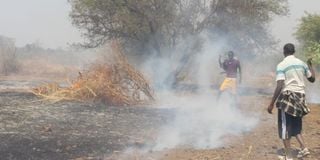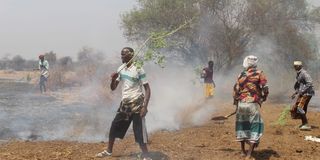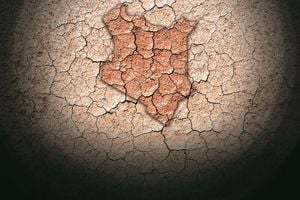
Residents of Korbesa sub location in Charab sub county in Isiolo put out a fire on January 21, 2025.
Residents of Makagala and Korbesa in Cherab Sub-County, Isiolo, are still battling a raging wildfire that has so far destroyed more than 200,000 acres of grazing land.
The residents on Wednesday said they've been trying to put out the flames for the last seven days in vain, even as they hit out at the national and county governments for neglecting them.
Adan Guyo, Korbisa assistant chief, said the fire started on Friday last week. The cause of the fire was linked to an attempt by herders to fight tick infestation in the expansive grazing lands.
“We have raised the matter with all authorities concerned but there is no help so far. So we mobilised our youth who have committed themselves to put out the fire but they cannot contain it,” said Mr Guyo.
Mr Daud Bicha, assistant chief of Makagala sub-location, said they have been deploying 20 men in the affected areas for the last seven days.

Residents of Korbesa sub location in Charab sub county in Isiolo put out a fire on January 21, 2025.
He said each of the groups had been spending about two days in the burning bushes without water or food.
“It has been very tough on them because they don’t have any equipment. They are using twigs and shovels to scoop soil which they dump on the edges of the fire. When they reach areas where there are huge flames, they retreat since it is overpowering,” he said.
The fire has displaced herders and livestock in grazing areas, forcing them to evacuate cattle to safety. Wildlife, including elephants and monkeys, were also forced to flee the raging flames.
The flames are being fueled by strong winds that are blowing in the county located in northern Kenya— more than 270 kilometres from the capital Nairobi.
According to residents, the fire is the worst since 2020 when thousands of acres were also destroyed.
They said the current fire had already destroyed pasture that would have lasted for three years even with failed rains.
The 2020 fire preceded a drought after the rains failed, with residents fearing that the same fate might befall them again.
“In 2021 we did not have good rains and it was after that when there was serious drought that extended to 2022 when thousands of livestock died. If the rains fail in March, we’re staring at a more serious drought,” said Mr Hassan Dabaso, a resident.
“Yesterday (Wednesday) we were busy trying to put out the fire but the flames overwhelmed us and we had to run for our lives. We call upon authorities to deploy all the machinery needed to contain the fire failure to which there will be a disaster,” Mr Dabaso said.
According to Isiolo County Commissioner Geoffrey Omoding, the fire is currently raging in Bassa, Matarba, and Sericho locations.
“We have mobilised locals who are trying to contain the fire in the morning and evening hours. Currently, we are sourcing machinery to help create fire breaks. Luckily, the fire is not near settlements,” Mr Omoding said.
The Kenya Red Cross said “the situation remains active” with attempts by a multi-agency response team and the community establishing firebreaks to contain the fire turning futile.
The humanitarian organisation, however, added that no injuries or displacements had so far been reported.
“The mobilisation of specialised equipment, led by National Disaster Operations Center, including bulldozers, tractors, excavators and air support, is still underway to scale up containment efforts,” the Red Cross said in a statement.













